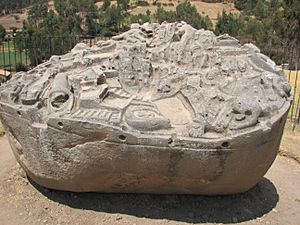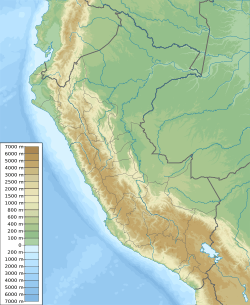Sayhuite facts for kids
|
Saywite
|
|

The Sayhuite monolith
|
|
| Location | Curahuasi, Abancay Province, Apurímac Region, Peru |
|---|---|
| Region | Andes |
| Coordinates | 13°32′50″S 72°48′10″W / 13.54722°S 72.80278°W |
| Type | Sanctuary |
Sayhuite (pronounced Sigh-weetey) is an ancient archaeological site in Peru. It is located about 47 kilometers (29 miles) east of the city of Abancay. This site is considered a special place where the Inca people worshipped, especially focusing on water.
Long ago, a writer named John Hemming described the Sayhuite temple. He said it had large columns covered in fancy fabrics and thick gold bands. A priestess named Asarpay cared for the temple. She chose to jump into a deep gorge nearby to avoid being captured by Spanish soldiers.
Contents
Discovering the Sayhuite Monolith
One of the most important things at Sayhuite is the monolith. This is a huge rock with over 200 carved shapes. These shapes include geometric patterns and animal figures like reptiles, frogs, and big cats.
What is the Monolith?
The monolith sits on top of a hill called Concacha. It was carved to look like a detailed map of a water system. It shows tiny terraces, ponds, rivers, tunnels, and irrigation channels. It's like a miniature landscape carved into stone!
No one knows for sure why the stone was made. But a researcher named Dr. Arlan Andrews, Sr. has an idea. He thinks the monolith was used as a model to plan and test water projects. It might have helped ancient engineers learn how to design water flow for their communities. The rock was changed many times, with new carvings added or water paths altered. This large stone is about two meters (6.5 feet) long and four meters (13 feet) wide. It is the most popular part of the Sayhuite site for visitors.
Why is the Monolith Important?
Even though we don't know who carved it, the monolith helps archaeologists understand the people who lived there before Columbus arrived. Experts have figured out that Sayhuite was an Inca religious center. Here, people performed rituals and ceremonies to worship water.
The monolith is a big clue because it shows water-like paths between the carvings. Archaeologist Gary Urton noted that the carvings show terraces, canals, pumas, and other animals. He thinks it might be a symbolic picture of the valley itself. The exact meaning of this stone is still a mystery. However, it is a key part of the Inca people's material culture. It helps archaeologists piece together how and why they lived the way they did. Understanding Inca culture helps us learn about other ancient civilizations too.
Visiting Sayhuite
The Sayhuite monolith is a popular spot for tourists. Its large size and detailed carvings make it very interesting to see. One idea is that the carvings show a religious ceremony, possibly linked to water, that the ancient Incas performed.
Encouraging people to visit and learn about the monolith is important. It helps everyone understand the value of archaeological sites. It also shows why it's so important to protect ancient objects and places.
Protecting Ancient Sites
Preserving the Sayhuite site and its monolith is very important. This is because archaeology itself can be a destructive process. Also, stealing artifacts (called looting) is a common problem at ancient sites. Looting makes it harder for archaeologists to study past peoples and their cultures.
How We Protect Sayhuite
Protecting Sayhuite means leaving some parts of the site unexcavated. It also means keeping the monolith safe from damage by people or weather. To stop vandalism and looting, teaching the public about the site is key. This helps people get involved in protecting a significant part of history. It also raises awareness about why preservation is so important in archaeology. Keeping the site safe allows for new technologies to be used in the future. These tools could help archaeologists understand the monolith's meaning even better.
See also
 In Spanish: Sayhuite para niños
In Spanish: Sayhuite para niños


